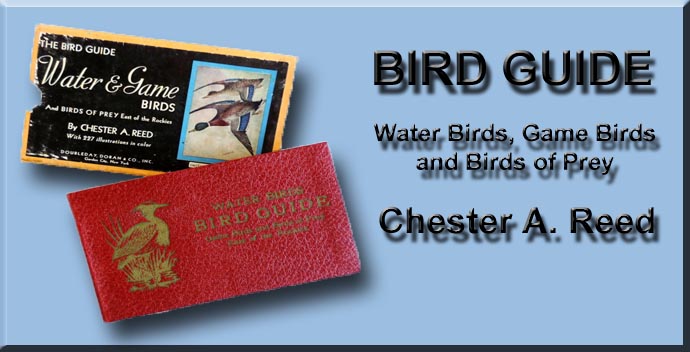
BIRD GUIDE
Water Birds, Game Birds and Birds of Prey
By Chester A. Reed
Order 11
PIGEONS AND DOVES
Order Columbę
|
|
||
Family Columbidę |
||
 |
PASSENGER PIGEON315. Ectopistes migratorius. 16 in. Head and back bluish-slate; below, rich rusty brown. Only a few years ago, up to 1880, they were extremely abundant in eastern North America. Seemingly incredible stories are told of the immense flocks and roosting places of these birds, and most of them are authentic. It is unfortunate that the camera was not extensively used then, so we have no visual records of them. A nesting place in Michigan is described as 28 miles in length by about four in width, and every tree in the woods, throughout this whole tract, had several nests, and some were filled with them. Flocks darkening the sky and covering several square miles are recorded. And, today, but one or two stragglers are reported in a year, and these are usually doubtful. They were shot and netted at their roosting and nesting places, barreled up and sent to market for sale, this continuing so long as there were birds enough to make it profitable, and we reap the result no birds. |
|
|
|
||
MOURNING DOVE316. Zenaidura macroura carolinensis. 12 in. Upperparts olive-brown; below, buffy-gray; a small black mark on the ears above the iridescent neck patch. These birds never flock as Passenger Pigeons did, traveling in companies of six to a dozen, and they have no common nesting or roosting places, but nest anywhere in the woods, orchards or vines. As they are not often hunted, they are not shy, and in some localities are very tame, especially when they are breeding. Their food consists of seeds, grain, berries and insects, most of which they get from the ground. They nest either in trees, bushes or on the ground, most often the former. Their nests are very frail platforms, composed of only a few twigs and rootlets; when on the ground, usually no nest is made. Their two eggs are pure white, as are those of all doves. They are loving birds, always cooing to each other, and are very attentive to their young until they are full grown. Range. Breeds throughout the United States and southern Canada, except northern New England and the Provinces. |
 |
|
|
|
||
 |
WHITE-FRONTED DOVE318. Leptotila fulviventris brachyptera. 12 in. No black ear-mark; under wing coverts rusty chestnut. Forehead whitish; all but central pair of tail feathers tipped with white. Nest. Indistinguishable from that of the next species. Range. Central America and Mexico, north in February to valley of Lower Rio Grande.
WHITE-WINGED DOVE319. Melopelia asiatica. 12 in. Large black patch on the ears: tail only moderately long, and broadly rounded, with large white ends to the outer feathers. Besides the regular cooing notes, common to doves, this species has a peculiar song likened by some, to the first attempts at crowing, of a young rooster. Nest. A shabby platform of twigs, lined with bits of weeds, moss and leaves; placed at any height from the ground in bushes, trees or cacti. Eggs white. Range. Texas, New Mexico, Arizona and casually southern Florida, southward. |
|
|
|
||
GROUND DOVE320. Chcetncpelia passerina terrcstris. 6.75 in. Size very small; tail short and nearly square. Back of head blue-gray; forehead and most of underparts pinkish. Bill, feet and eye, more or less red. Nest. A frail structure of twigs, lined with pine needles; placed usually at few elevations in bushes. The two eggs are pure white. Range. South Atlantic and Gulf States; abundant near the coasts; winters throughout its range. 320a., Mexican Ground Dove, found from Texas to California, is slightly paler than the eastern species.
INCA DOVE312. Scardafella inca. 8 in. Tail long, with the outer feathers tipped with white, and shorter than the middle ones. Feathers mostly margined with brownish-black. The bases of the primaries are bright chestnut, and the whole underwing is of that color; bill black; eye and feet reddish. Range. Southern Texas, southern Arizona and southern New Mexico. |
 |
|
 |
 |
|
|
|
-
Site Navigation
 Home
Home What's New
What's New Bible
Bible Photos
Photos Hiking
Hiking E-Books
E-Books Genealogy
Genealogy Profile
Free Plug-ins You May Need
Profile
Free Plug-ins You May Need
 Get Java
Get Java.png) Get Flash
Get Flash Get 7-Zip
Get 7-Zip Get Acrobat Reader
Get Acrobat Reader Get TheWORD
Get TheWORD